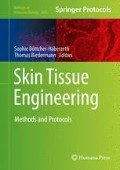Abstract
Tissue engineering of skin is a field with high research activities and major importance for wound healing, especially following burn injuries. Animal models enable to test tissue-engineered skin as well as different types of cells in a realistic setting. Although there are several challenges in working with pigs, it is a good model because of its similarity to the human skin and a comparable wound regeneration. Here, we explain our routinely used methods for using pig models to test tissue-engineered skin in burn injuries.
Access this chapter
Tax calculation will be finalised at checkout
Purchases are for personal use only
References
Shevchenko RV, James SL, James SE (2010) A review of tissue-engineered skin bioconstructs available for skin reconstruction. J R Soc Interface 7:229–258
Huang S, Fu X (2011) Tissue-engineered skin: bottleneck or breakthrough. Int J Burn Trauma 1(1):1–10
Finnerty CC et al (2016) Hypertrophic scarring: the greatest unmet challenge following burn injury. Lancet 388(10052):1427–1436
Saaiq M, Zaib S, Ahmad S (2012) Early excision and grafting versus delayed excision and grating of deep thermal burns up to 40% total body surface area: a comparison of outcome. Ann Burns Fire Disasters 25(3):143–147
Ayaz M et al (2014) Early Excision and grafting versus delayed skin grafting in burns covering less than 15% of total body surface area; a non- randomized clinical trial. Bull Emerg Trauma 2(4):141–145
Herndon DN et al (1989) A comparison of conservative versus early excision. Therapies in severely burned patients. Ann Surg 209(5):547–553
Kapp MB (2006) Ethical and legal issues in research involving human subjects: do you want a piece of me? J Clin Pathol 59(4):335–339
Rheinwald JG, Green H (1977) Epidermal growth factor and the multiplication of cultured human epidermal keratinocytes. Nature 265(5593):421–424
Sullivan TP et al (2001) The pig as a model for human wound healing. Wound Repair Regen 9(2):66–76
Ignacio G, El-Amin I, Mendenhall V (2016) Animal models for wound healing. in Skin tissue engineering and regenerative medicine eds. Albanna M, JH Holmes IV, New York: Academic Press/Elsevier 387–400
Meyer W, Schwarz R, Neurand K (1978) The skin of domestic mammals as a model for the human skin, with special reference to the domestic pig. Curr Probl Dermatol 7:39–52
Heinrich W et al (1971) Isolation and characterization of the large cyanogen bromide peptides from the alpha1- and alpha2-chains of pig skin collagen. FEBS Lett 16(1):63–67
Morris GM, Hopewell JW (1990) Epidermal cell kinetics of the pig: a review. Cell Tissue Kinet 23(4):271–282
National Research Council (1996) Guide for the care and use of laboratory animals. National Academy Press, Washington, DC. ISBN: 0309132622
Branski LK et al (2008) A porcine model of full-thickness burn, excision and skin autografting. Burns 34(8):1119–1127
Lammers G et al (2011) An overview of methods for the in vivo evaluation of tissue-engineered skin constructs. Tissue Eng 17(1):33–55
Verhaegen PD et al (2009) Differences in collagen architecture between keloid, hypertrophic scar, normotrophic scar, and normal skin: an objective histopathological analysis. Wound Repair Regen 17(5):649–656
Swindle MM, Smith AC (2007) Swine in the laboratory: surgery, anesthesia, imaging, and experimental techniques, vol 2. CRC Press, Boca Raton, FL. ISBN: 9781466553477
Middelkoop E et al (2004) Porcine wound model for skin substitution and burn treatment. Biomaterials 25(9):1559–1567
Abdullahi A, Amini-Nik S, Jeschke MG (2014) Animal models in burn research. Cell Mol Life Sci 71(17):3241–3255
Wachtel TL, et al. (1972) Determining the surface areas of miniature swine and domestic swine by geometric design – a comparative study. USAARL Report, 73-3
Braziulis E et al (2011) Skingineering I: engineering porcine dermo-epidermal skin analogues for autologous transplantation in a large animal model. Pediatr Surg Int 27:241–247
Author information
Authors and Affiliations
Corresponding author
Editor information
Editors and Affiliations
Rights and permissions
Copyright information
© 2019 Springer Science+Business Media, LLC, part of Springer Nature
About this protocol
Cite this protocol
Tapking, C., Popp, D., Branski, L.K. (2019). Pig Model to Test Tissue-Engineered Skin. In: Böttcher-Haberzeth, S., Biedermann, T. (eds) Skin Tissue Engineering. Methods in Molecular Biology, vol 1993. Humana, New York, NY. https://doi.org/10.1007/978-1-4939-9473-1_19
Download citation
DOI: https://doi.org/10.1007/978-1-4939-9473-1_19
Published:
Publisher Name: Humana, New York, NY
Print ISBN: 978-1-4939-9472-4
Online ISBN: 978-1-4939-9473-1
eBook Packages: Springer Protocols

